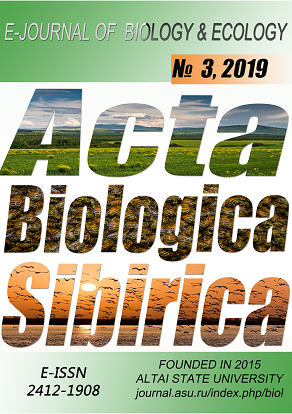Abstract
This paper provides an overview of the floristic diversity of the forest-steppe complex of the "Boizhy" tract in the Prikalaus-Buivolinsky landscape. The description of the relief of the territory and its forms is given, the bedrocks, soil types, etc. are noted. Despite its phytodiversity, the territory is not studied botanically. For the first time, a description of the vegetation cover of flat areas, slopes, beams, pots with the corresponding floristic series is given. The main dominants of the tree and shrub layer, as well as species with a broad ecological valence, are indicated. On the territory of the study area, xerophilic and petrophilic groups were identified, which form the basis of the rarity flora of the tract.
References
Belous V. N. (2012a). Some aspects of the biological diversity of the plant component of the Kalantai tract (Stavropol upland). Botany problems of Southern Siberia and Mongolia, 26–28 (In Russian).
Belous V. N. (2012b). Knowledge of the flora and vegetation of the western slope of the Prikalus heights. Problems of environmental safety and conservation of natural resource potential, 64–69 (In Russian).
Belous V. N., Likhvar A. V. (2018). Plant communities of the steppe complex of the Middle Kalaus (Stavropol upland). Systematic and floristic studies of Northern Eurasia (to the 90th anniversary of the birth of Professor A. G. Yelenevsky), 79–82 (In Russian).
Dzybov D. S. (2018). Rastitel'nost' Stavropol'skogo kraya [Vegetation of the Stavropol еerritory]. Stavropol, 492 (In Russian).
Dzybov D. S, Lapenko N. G., Druzhinin V. A., Dudchenko L. V. (2006). Geobotanical sketch of the steppe vegetation of the Grachevsky district of the Stavropol territory. Land resources. State and prospects of use, 41–45 (In Russian).
Dudar Yu. A. (1995). Rastitel'nost' Stavropol'ya [Vegetation of Stavropol]. Stavropol. 114 (In Russian).
Kononov V. N. (1980). The main features of the steppes of the Stavropol. Steppe and meadows of the Stavropol territory, 6–16 (In Russian).
Kononov V. N., Tanfiliev V. G., Gnilovskoi V. G. (1968). Map of the vegetation of the Stavropol territory. In: Atlas Stavropol'skogo kraya [Atlas of the Stavropol territory]. M.oscow, 17. (In Russian).
Lykhvar A. V. (2018). On the history of the study of the steppe flora of the Central Ciscaucasia. Samarskaya Luka: problems of regional and global ecology, 27(4), 116–122 (In Russian).
Novopokrovsky I. V. (1927). Rastitel'nost' Stavropol'ya [Vegetation of Stavropol]. Rostov-on-Don, 194 (In Russian).
The Red Book of the Stavropol territory. (2013). V. 1. Plants. Stavropol, 400 (in Russian).
Shalnev V. A. (1995). Landshafty Stavropol'skogo kraya. [Landscapes of the Stavropol territory]. Stavropol, 52 (In Russian).
Acta Biologica Sibirica is a golden publisher, as we allow self-archiving, but most importantly we are fully transparent about your rights.
Authors may present and discuss their findings ahead of publication: at biological or scientific conferences, on preprint servers, in public databases, and in blogs, wikis, tweets, and other informal communication channels.
ABS allows authors to deposit manuscripts (currently under review or those for intended submission to ABS) in non-commercial, pre-print servers such as ArXiv.
Authors who publish with this journal agree to the following terms:
- Authors retain copyright and grant the journal right of first publication with the work simultaneously licensed under a Creative Commons Attribution License (CC BY 4.0) that allows others to share the work with an acknowledgement of the work's authorship and initial publication in this journal.
- Authors are able to enter into separate, additional contractual arrangements for the non-exclusive distribution of the journal's published version of the work (e.g., post it to an institutional repository or publish it in a book), with an acknowledgement of its initial publication in this journal.
- Authors are permitted and encouraged to post their work online (e.g., in institutional repositories or on their website) prior to and during the submission process, as it can lead to productive exchanges, as well as earlier and greater citation of published work (See The Effect of Open Access).





